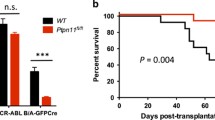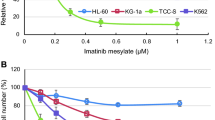Abstract
Bcr-Abl is a constitutively active tyrosine kinase that is expressed in Philadelphia chromosome (Ph1)-positive human leukemias. Bcr-Abl has been shown to inhibit apoptosis and cause anchorage independent growth. However, its ability to activate mitogenic signaling pathways is controversial. Here we show that Bcr-Abl signaling prevents down-regulation of cyclin-dependent kinase activity and cell cycle arrest after growth factor deprivation of hematopoietic progenitor cells. Using an inducible system to regulate Bcr-Abl expression, we also demonstrate that Bcr-Abl expression is sufficient to induce G1-to-S phase transition, DNA synthesis, and activation of cyclin-dependent kinases in cells that were arrested in G0 by growth factor deprivation. Furthermore, Bcr-Abl activates Ras, Erk, and Jnk pathways as a primary consequence of expression. These data show that Bcr-Abl is one of a select group of oncogenes that is capable of both inhibiting apoptosis and deregulating cell proliferation. The combination of these activities is likely to be important for the progression of CML.
Similar content being viewed by others
Author information
Authors and Affiliations
Rights and permissions
About this article
Cite this article
Cortez, D., Reuther, G. & Pendergast, A. The Bcr-Abl tyrosine kinase activates mitogenic signaling pathways and stimulates G1-to-S phase transition in hematopoietic cells. Oncogene 15, 2333–2342 (1997). https://doi.org/10.1038/sj.onc.1201400
Received:
Revised:
Accepted:
Issue Date:
DOI: https://doi.org/10.1038/sj.onc.1201400
- Springer Nature Limited
Keywords
This article is cited by
-
ASXL1/2 mutations and myeloid malignancies
Journal of Hematology & Oncology (2022)
-
Eliminating chronic myeloid leukemia stem cells by IRAK1/4 inhibitors
Nature Communications (2022)
-
Repositioning antispasmodic drug Papaverine for the treatment of chronic myeloid leukemia
Pharmacological Reports (2021)
-
SRSF1 mediates cytokine-induced impaired imatinib sensitivity in chronic myeloid leukemia
Leukemia (2020)
-
Stem cell persistence in CML is mediated by extrinsically activated JAK1-STAT3 signaling
Leukemia (2019)




